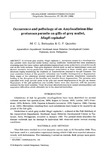Occurrence and pathology of an Amyloodinium-like protozoan parasite on gills of grey mullet, Mugil cephalus
Share
Abstract
In cultured grey mullets, Mugil cephalus L., mortalities caused by a dinoflagellate-like parasite were observed under normal rearing conditions. Moribund fish were abnormally swimming near the water surface and exhibited haemorrhagic areas on the head, around the mouth and on the body surfaces. Their gills displayed whitish spots as well as haemorrhagic areas and showed excessive mucus production. Microscopic examination of these whitish spots revealed structures highly resembling the trophonts of Amyloodinium attached to the gill filaments. The most consistent feature of this parasitic infestation was lamellar disintegration or degeneration. Early stages of the infestation showed epithelial lifting and lamellar detachment, eventually leading to the disruption of the lamellae and lamellar tissue degeneration. The parasites were associated with large necrotic areas in the gills and caused degeneration of the gill ray tissues. Hyperplasia of the gill epithelium and lamellar fusion were also observed, with the parasites enclosed by the fused lamellae. These structural alteration may have caused osmoregulatory and respiratory difficulties which ultimately led to the observed mortalities.
Description
SEAFDEC Contribution No. 140.
Suggested Citation
Baticados, M. C. L., & Quinitio, G. F. (1984). Occurrence and pathology of an Amyloodinium-like protozoan parasite on gills of grey mullet, Mugil cephalus. Helgolander Meeresuntersuchungen , 37(1-4), 595-601. http://hdl.handle.net/10862/1148
Subject
Taxonomic term
Collections
- AQD Journal Articles [1248]

